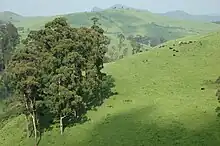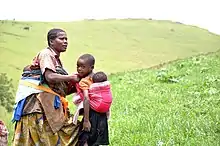Masisi Territory | |
|---|---|
Masisi on a map of North Kivu Province | |
_-_Nord-Kivu.svg.png.webp) North Kivu on a map of DR Congo | |
| Country | |
| Province | North Kivu |
| Area | |
| • Total | 4,734 km2 (1,828 sq mi) |
| Population (2020)[1] | |
| • Total | 843,396 |
| • Density | 180/km2 (460/sq mi) |
| Time zone | UTC+2 (CAT) |

Masisi Territory is a territory which is located within the North Kivu Province of the Democratic Republic of the Congo. Its political headquarters are located in the town of Masisi.
Overview
Masisi territory has an area of 4734 km2. Masisi Territory is administratively subdivided into four sectors: Bahunde, Bashali, Katoyi, and Osso.[2]
Masisi is bordered by Walikale Territory on the west and north, Rutshuru Territory to the northeast, Nyiragongo Territory and Goma to the east, and South Kivu to the south.
Language-wise French is the DRC's administrative language. The most common language for a majority of the local population (56%) is Swahili. Many of the migrants with Rwandan background speak Kinyarwanda (15%), while some of the natives speak Hunde (20%). A few people speak Tembo (2%), who migrated from Lubero Territory and Beni Territory, and a few others speak Nande (2%), which is more common in the south of Masisi in the two Ufamando groupings.[1]
The following lists the organizational subunits of the territory, as of 1977.[3]
- Masisi Territory
- Bahunde Chiefdom
- Muvunyi-Karuba
- Muvunyi-Kibabi
- Muvunyi-Matanda
- Muvunyi-Shanga
- Ufamando I
- Bashali Chiefdom
- Bashali Mokoto
- Bashali Kaembe
- Katoyi Sector
- Kambuli
- Lwindi
- Nyalipe
- Nyamaboko II
- Ufamando II
- Osso Sector
- Bapfuna
- Banyungu
- Bigiri
- Bugabo
- Nyamaboko I
- Bahunde Chiefdom
Locations
The administrative center of the territory is the town of Masisi, which contains Masisi Hospital, run by aid agency Médecins Sans Frontières, treats civilians and fighters from all sides of the conflict.[4] The town is inaccessible much of the time, due to fighting.
The town of Sake in Masisi, located at a crossroads, is the main headquarters of the United Nations Force Intervention Brigade (part of MONUSCO).
Other settlements in Masisi include Karuba and Burungu, as well as the coltan mining center of Rubaya. Near the town of Mweso there is a tea processing plant as part of a 450 hectare tea plantation known as JTN.[5] Beginning in 1975, Belgian priests introduced a cheese-making tradition, and small farmers in the area produce Goma cheese, a Gouda-like cow cheese that is the only significant cheese production in the whole DRC.[6][7]
The eastern portion of the territory is part of Virunga National Park, and contains the active volcano Nyamuragira and its satellite Rumoka.
History
The area was traditionally inhabited mostly by the Hunde people, as well as some Twa people. With support from the Belgians, one of the small local chiefs, Mwami André Kalinda, expanded his chiefdom, the Grande Chefferie des Bahunde to encompass of all of Masisi by 1935.[8]
During the colonial period in the 1940s and 1950s, the Belgian administration had a "dual colonization" policy of bringing in many immigrant white people and Banyarwanda (Hutus and Tutsis) to settle in the area, based on the promise of land. The colonial parastatal Comité national du Kivu gave out long term leases to the settlers in Bashali Chiefdom, to focus on tea and pyrethrum cash crops.[9]
During the Congo crisis in the early 1960s, voting rights were first granted to the Rwandan immigrants. Their immediate electoral success prompted a backlash from the Hunde population, who took control of local politics under the slogan udongo ya baba (father's land). Increasing violence between the Hunde administration and the immigrant population spiraled into the Kanyarwanda War. The violence prompted most of the white settlers to leave, with all the remaining whites gone after the implementation of the Zaïranization policy in the early 1970s.[3]
Historical events such as the 1977 eruption of Mount Nyiragongo prompted additional immigration to the area. The Banyarwanda acquired the overwhelming majority of the ex-colonial plantations, such as the case of Barthélémy Bisengimana, who served as chief of staff for DRC president Mobutu as well as taking over the large Osso concession in Masisi.[10]
Since at least the 1970s, the territory has been divided into the four modern collectives: Bahunde chiefdom and Bashali chiefdom are run by the traditional ethnic Hunde chiefs, and Katoyi and Osso are organized as sectors.[11]
Conflict
Masisi War (1993)
Beginning in March 1993, the conflict broke out along ethnic lines in nearby Walikale Territory. Although fighting ended in Walikale after two weeks, the violence had since spread to Masisi Territory and the Bwito Chiefdom (western Rutshuru Territory).[3][12]
This began with militias made up of the autochtone populations (Nyanga people, Hunde people, and Twa people), conducting a campaign aimed at forcibly removing the majority Hutu population from Walikale and Masisi. According to Doctors Without Borders, the fighting in March and May 1993 killed between 6,000 and 15,000 and displaced 250,000.[13]
Peace negotiations were attempted, but violence resumed in 1994, and then escalated significantly with the Great Lakes refugee crisis when there was an influx of around 600,000 Rwandan refugees due to Rwandan Genocide and related Hutu-Tutsi conflict.[14]
First Congo War (1996–1997)
In the 1990s, Mobutu Sese Seko, the long-time dictator of the DRC, was facing growing opposition from various factions in the country, including rebel groups in the east. In 1996, a coalition of rebel groups, backed by neighboring Rwanda and Uganda, launched an offensive against Mobutu's forces. The rebels quickly gained control of much of eastern Congo, including Masisi Territory, and Mobutu was forced to flee the country in May 1997.
Second Congo War (1998–2003)
After Mobutu's ouster, Laurent-Désiré Kabila assumed power in the DRC. However, Kabila's rule was also marked by conflict and instability, as various rebel groups sought to gain control of the country's vast mineral resources. In 1998, a new rebellion broke out in the east of the country, led by the Rally for Congolese Democracy (RCD). The rebels quickly gained control of Masisi Territory and other areas of eastern Congo, and a new round of fighting began.
This round of conflict, the Second Congo War, also known as the African World War, was a complex conflict involving multiple rebel groups, foreign armies, and various factions within the DRC. In the course of the conflict, the original RCD faction fractured into several groups, with the Rally for Congolese Democracy–Goma maintaining control of Masisi. The war officially ended in 2003 with the signing of the Sun City Agreement, but fighting continued in some parts of the country, including Masisi Territory.
During the conflict, Masisi Territory was a hotspot of violence and human rights abuses, with numerous reports of massacres, rape, and other atrocities committed by both rebel groups and government forces. The conflict also had a devastating impact on the local economy and infrastructure, with many villages and towns destroyed and large numbers of people displaced.
Post-Congo Wars

Masisi Territory has constantly been subjected to the conflict between the Congolese army and militias, which has plagued the eastern Congo since the ending of the Second Congo War. militias originating from the Rwandan genocide and the Congolese civil war, and Ugandan rebel groups, are involved in these episodes of conflict, which also relates to Rwandan border security and the control of eastern Congo's minerals by rebel groups and business interests. Armed groups have systematically targeted the civilian population.
One of the armed groups active in the territory is Nyatura, a majority Hutu militia which was founded in 2010 in nearby Kalehe Territory in South Kivu.[15] Another active group is the Alliance of Patriots for a Free and Sovereign Congo (APCLS), a majority Hunde Mai-Mai.
In July 2014, an offensive in the Masisi and Walikale Territories by the Congolese army and UN forces liberated 20 rebel controlled towns, freeing the local residents.[16]
As of 2023, the majority Tutsi March 23 Movement has taken control of portions of the territory during its recent offensive. The Nyatura and APCLS militias are currently in a coalition to resist the M23.[17]
References
- 1 2 3 "Cellule d'Analyses des Indicateurs de Développement". CAID (in French). Archived from the original on 2021-11-28. Retrieved 2023-03-26.
- ↑ Blaes, X. (October 2008). "Découpage administratif de la République Démocratique du Congo" (PDF). PNUD-SIG. Archived from the original (PDF) on 2010-04-01. Retrieved 2011-12-09.
- 1 2 3 Mararo, Bucyalimwe (1997). "Land, Power, and Ethnic Conflict in Masisi (Congo-Kinshasa), 1940s-1994". The International Journal of African Historical Studies. JSTOR. 30 (3): 503. doi:10.2307/220574. ISSN 0361-7882.
- ↑ Arnaud Zajtman: "Behind DR Congo's war games." BBC News online, Friday, 19 October 2007
- ↑ "Tea factory struggles on amid clashes in east DR Congo". France 24. 2019-04-26. Retrieved 2023-03-17.
- ↑ Jullien, Maud (2014-02-04). "The rare art of cheese-making in DR Congo". BBC News. Retrieved 2023-04-16.
- ↑ "The world's least blessed cheesemakers are in Congo". The Economist. 2018-09-13. Retrieved 2023-04-16.
- ↑ Jason Stearns (2012). "North Kivu: The Background to Conflict in North Kivu Province of Eastern Congo" (PDF). The Rift Valley Institute. p. 13. Retrieved 2023-03-13.
- ↑ van Leeuwen, Mathijs; Mathys, Gillian; de Vries, Lotje; van der Haar, Gemma (2020-12-04). "From resolving land disputes to agrarian justice – dealing with the structural crisis of plantation agriculture in eastern DR Congo". The Journal of Peasant Studies. Informa UK Limited. 49 (2): 309–334. doi:10.1080/03066150.2020.1824179. hdl:1854/LU-8685623. ISSN 0306-6150.
- ↑ Blaise Muhire (2017). "Legal Pluralism, Customary Authority and Conflict in Masisi, (Eastern) Democratic Republic of Congo". The Journal of Sociology and Development. 1 (1). ISSN 2591-6955.
- ↑ Elias Pottek (2007). "Communal Conflict and the Geopolitics of Land, Ethnicity and Territoriality in North Kivu, Democratic Republic of Congo" (PDF). p. 104. Retrieved 2023-03-13.
- ↑ Mararo, Stanislas Bucyalimwe (2005). "Kivu and Ituri in the Congo War: The Roots and Nature of a Linkage". The Political Economy of the Great Lakes Region in Africa. London: Palgrave Macmillan UK. pp. 190–222. doi:10.1057/9780230523890_8. ISBN 978-1-349-52574-4.
- ↑ Jason Stearns (2010-08-27). "Highlights from leaked UN draft report on Congo atrocities: 1993-1996". The Christian Science Monitor. Retrieved 2023-03-30.
- ↑ "Masisi, Down the Road from Goma: Ethnic Cleansing and Displacement in Eastern Zaire - Democratic Republic of the Congo". ReliefWeb. 1996-06-30. Retrieved 2023-03-30.
- ↑ "Sud-Kivu : la situation sécuritaire toujours tendue à Fizi et Uvira - Democratic Republic of the Congo". ReliefWeb (in French). 2011-11-03. Retrieved 2023-03-14.
- ↑ Military Offensives Free DRC Villages Voice of America. 28 July 2014.
- ↑ "Rebel clashes break out in DR Congo's east". France 24. 2022-12-16. Retrieved 2023-03-17.